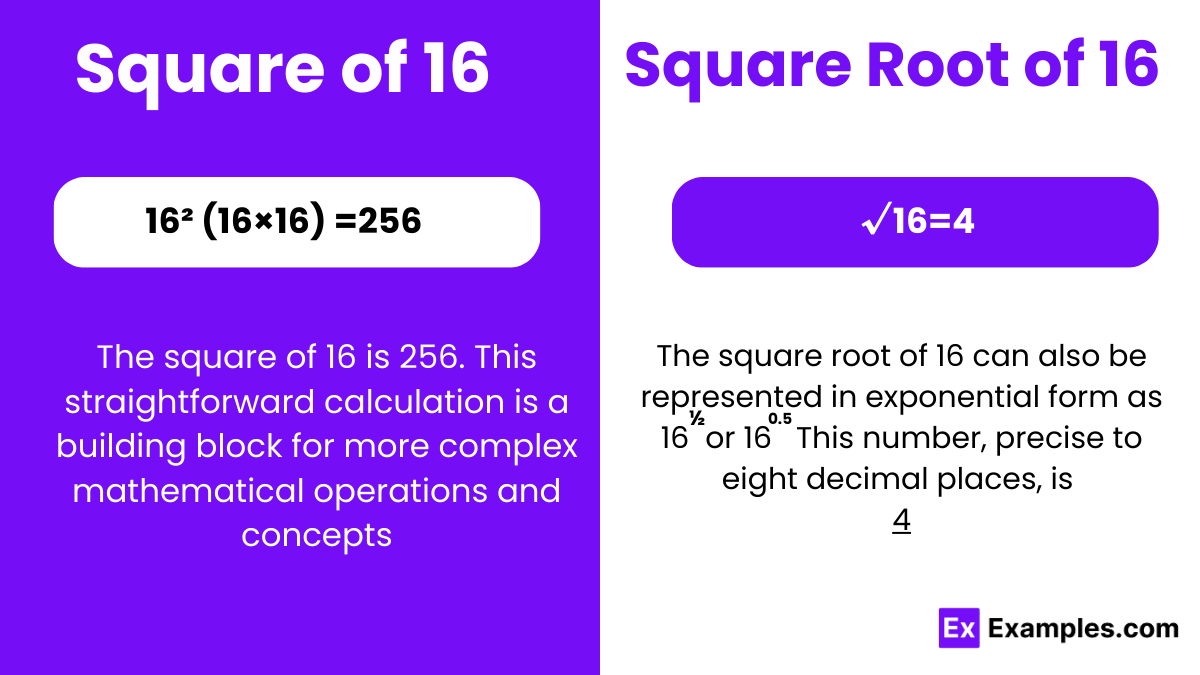What is the square of 16?
256
264
364
664


To calculate the square Number of 16, you multiply the number by itself:
Squaring the number 16 results in 256. This is a basic arithmetic operation where you take the number 16 and multiply it by itself to obtain the square. Squaring numbers is a key mathematical skill, useful in various disciplines including geometry, algebra, and physics. For practical calculations, especially with smaller numbers like 16, this can easily be done mentally or using simple tools such as a basic calculator.
The square root of 16, denoted as √16, is 4. This value represents the number which, when multiplied by itself, gives 16. The square root of 16 is a perfect square, meaning its square root is an integer.
This concept is fundamental in mathematics and finds applications across various fields such as geometry, where it might be used to determine the length of the sides of squares or rectangles. Knowing that the square root of 16 is 4 allows for straightforward and precise calculations in everyday math, engineering, architecture, and more.
Square Root of 16: 4
Exponential Form: 16^½ or 16^0.5
Radical Form: √16
Here’s why: The square root of 16 is 4, which is an integer. Any number that can be written as a simple fraction (like 4/1) is considered a rational number. So, since 4 is a whole number and fits this definition, it means the square root of 16 is a rational number.
To find the square root of 16, you can use several methods. Here are a few easy ones:
1. Guess and Check Method:
You guess a number that when squared gives 16. For example, you know 4 squared is 16, so √16 = 4 .
2. Prime Factorization:
Factorize 16 into prime factors: 16 = 2× 2 × 2 × 2. Pair the factors: (2 × 2) × (2 × 2 ). Take one element from each pair: 2×2=4 so √16 = 4 .
3. Division Method:
Start by dividing the number (16) by a guess (say 4). Take the average of the guess and the quotient to get a better guess: Average of 4 and (16/4)=Average of 4 and 4=4. Since the guess does not change after averaging, √16 = 4 .
4.Using a Calculator:
If you prefer using technology, simply enter 16 and press the square root function to get the result √16 = 4 . Any of these methods will reliably show that the square root of 16 is 4, making it a straightforward calculation due to 16 being a perfect square.

To find the square root of 16 using the long division method, follow these step-by-step instructions. This method is similar to traditional long division and helps you determine the square root by breaking down the number into pairs of digits:
Step-by-Step Process:
Step 1: Set Up Your Problem:
Write the number 16. You can group the digits starting from the decimal point (if there is no decimal, assume it at the end of the number) in pairs of two from right to left. In this case, you only have the digits “16”.
Step 2: Initial Guess:
Find the largest square less than or equal to 16. Since 4² = 16,exactly, 4 is your initial guess.
Step 3: Subtraction:
Subtract 4² (which is 16) from the 16 you started with, giving you a remainder of 0.
Bring Down Next Pair (if applicable):
If there were more digits or a decimal, you would now bring down the next pair of digits next to the remainder. But since the remainder is 0 and there are no more digits, the division is complete.
Step 4: Repeat if Needed:
Normally, you would now make a new guess based on the new number formed by the remainder and the next pair of digits brought down. However, as the remainder is 0, no further steps are required.
A perfect square is a number that can be expressed as the square of an integer. In the case of 16, it can be expressed as 4² (4 times 4), making it a perfect square.
No, 16 is not a perfect number. A perfect number is defined as a number that is equal to the sum of its proper divisors, excluding itself.
No, 16 is not a prime number. A prime number is defined as a number greater than 1 that has no positive divisors other than 1 and itself. Since 16 can be divided evenly by 1, 2, 4, 8, and 16, it has divisors other than just 1 and itself, making it a composite number.
Text prompt
Add Tone
10 Examples of Public speaking
20 Examples of Gas lighting
What is the square of 16?
256
264
364
664
Find the square root of 16.
2
4
5
6
What is the value of 16 squared?
100
126
256
345
If x² = 16, what is the value of x?
4
- 4
Both 4 and -4
8
What is the result of 16 raised to the power of 1/2?
4
8
16
32
What is the square of the square root of 16?
16
32
48
64
Find the number whose square is 16.
Both 4 and -4
4
-4
8
What is the square of 8 divided by the square root of 16?
2
4
6
8
What is the result when you subtract the square root of 16 from 16?
8
10
12
14
If 16 is a perfect square, what is its square root?
4
8
16
32
Before you leave, take our quick quiz to enhance your learning!

